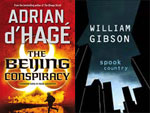Last month I took part in a fascinating discussion about the impact of social media and related breakthroughs at Consilium [PDF], an invitation-only annual conference put together by the Centre for Independent Studies. Here’s part of what I said.
Continue reading “Consilium: Social media is destroying society? Good!”Review: “Without Warning” by John Birmingham
John Birmingham has followed up his highly-successful Axis of Time trilogy of military thrillers with another “ripper yarn” novel, Without Warning: America is Gone. It’s a good read, but not as good as it could be.
Like Axis of Time, which posited a 21st-century naval task force suddenly finding itself at the Battle of Midway and the final volume of which I reviewed earlier, Without Warning is alternative history. One the eve of the 2003 Iraq War, an unexplained energy field obliterates all human life across most of the United States. As the world realises the last remaining superpower is gone, the novel tracks the political and military conflicts which emerge through the eyes of characters ranging from a US general at Guantanamo Bay to a female assassin working undercover in France.
My perceptions of Without Warning are coloured by Katie Harris’ comment that my recent Gonzo Twitter effort was like Hemingway. I still haven’t read any Hemingway, but I’ve been thinking about writing styles. In a previous review I described William Gibson’s noir prose as “a richly textured cabernet merlot” in comparison with the “slab of VB” simplicity of Adrian d’Hagé’s action thriller. Birmingham’s writing is another slab of VB. It’s a fast, easy read without too many difficult words or complex metaphors to slow you down.
Continue reading “Review: “Without Warning” by John Birmingham”
Vale Scott Young

I’ve just had the most amazing conversation about the man in the photograph. C Scott Young was, according to Mark Pesce, “the very, very first VRML designer. What he did — with no tools and for (literally) no money — changed the world.” And Mark should know, because he invented VRML.
Alas, Scott died a few days ago after a long, long battle with diabetes-related illnesses. He doesn’t have his own Wikipedia entry yet, but you can get hints of his life in Mark’s personal blog post and the memorial site.
Tonight’s conversation was remarkable because it led me to re-read a somewhat influential Wired article from 1995, Technopagans: May the astral plane be reborn in cyberspace. When that article hit the streets I’d just moved to Sydney in the first dot.com boom. Mark Pesce was a minor superstar in the Internet firmament for inventing leading-edge virtual reality technology — he was, almost literally, creating the world of William Gibson‘s Neuromancer.
That article combined what I knew of Mark’s technical work with religious and spiritual ideas which were at least somewhat related to my own. I remember thinking, “I’d very much like to meet this man one day.” That’s why I was so well pleased when I finally did meet him last December.
Mark, I am truly sad that you’ve lost a good friend — especially since there was so much complex news for you this week. As you say, “Remembering is the only gift we living can give those gone before us.”
Another Tale of Two Thrillers

One of my six special vices is reading thrillers, often very trashy ones. So it was an especially wonderful pleasure to read two thrillers in a week — from opposite ends of the trashiness spectrum.
Adrian D’Hagé‘s action thriller The Beijing Conspiracy is like demolishing a slab of VB with mates on a Friday night. It’s loud, fast-paced and perhaps a little clichéd. But it’s great fun and you know you’ll be back for more. I ploughed through it in less than 24 hours.
By comparison, William Gibson‘s Spook Country is like a richly textured cabernet merlot. Take it slowly to appreciate the subtleties, and your time will be generously rewarded.


